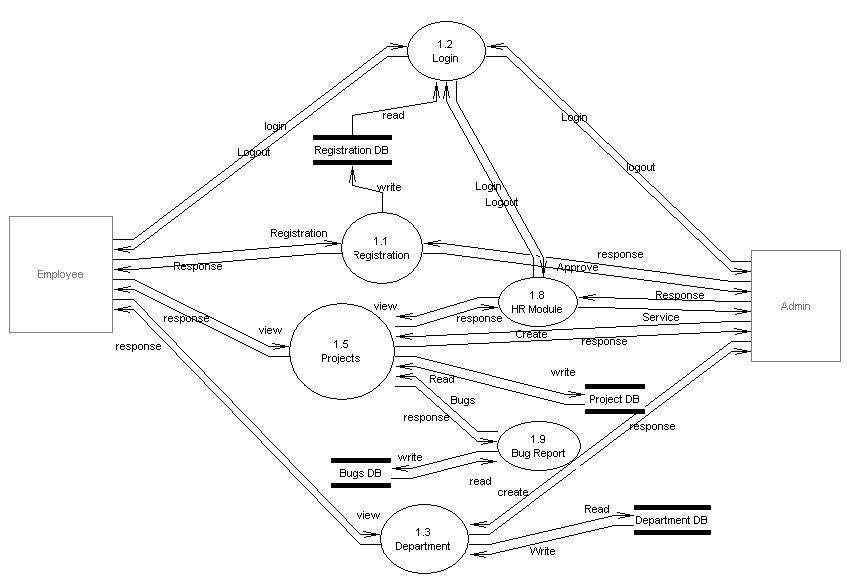
International Research Journal of Engineering and Technology (IRJET) e-ISSN: 2395-0056
Volume: 12 Issue: 04 | Apr 2025 www.irjet.net p-ISSN: 2395-0072


International Research Journal of Engineering and Technology (IRJET) e-ISSN: 2395-0056
Volume: 12 Issue: 04 | Apr 2025 www.irjet.net p-ISSN: 2395-0072
Sachin Meshram1, Tanvi Tembhare2, Rashmi Khandalkar3 , Sejal Gadhave4 , Ankesh Lilhare5
1 Professor, Dept. of Information Technology, Kavikulguru Institute of Technology and Science, Ramtek 2-5 Student, Dept. of Information Technology, Kavikulguru Institute of Technology and Science, Ramtek
Abstract - The defect Detection System mechanism is employed only in some large software development houses. Most of the others never botheredwith bugtrackingatall,and instead simply relied on shared lists and email to monitor the status of defects. This error-prone procedure tends to cause those bugs judged least significant by developers to be dropped or ignored. The defect tracking system features a user-friendly interface with interactive visualization tools, fostering collaborationamong team members andpromoting transparency throughout the developmentlifecycle.Real-time notifications and status updates ensure timely responses to reported bugs, reducing resolution times, and improving overall project management. The Defect Tracking System can dramatically increase the productivity and accountability of individual employees by providing a documented workflow and positive feedback for good performance. Software development projects often encounter numerous challenges, with bug tracking being a critical aspect affecting project success.
KeyWords: VisualizationTools,FosteringCollaboration, Real-time notification, Positive feedback, Software development, Bug Tracking.
ADefectDetectionSystemusingtheRationalRoseSystemis acrucialtoolthathelpsdevelopmentteamsefficientlytrack, manage, and resolve software defects throughout the software lifecycle. This system ensures better software quality, enhances productivity, and streamlines collaboration among developers, testers, and project managers.Softwaredevelopmentinvolvesmultiplestages, includingdesigning,coding,testing,anddeployment.Oneof the most crucial aspects of software quality assurance is trackingandmanagingdefectsorbugsthatariseduringthe developmentprocess.ADefectandBugTrackingSystemis designed to efficiently log, track, and manage software defects, ensuring that they are resolved in a structured manner. This system enables development teams to documentbugs,assignthemtotheresponsiblepersonnel, track their progress, and ensure timely resolution. It enhances collaboration among developers, testers, and project managers by providing a centralized platform for issue management. A Defect and Bug Tracking System is designed to efficiently log, track, and manage software defects, ensuring that they are resolved in a structured manner.
TheprimarypurposeoftheDefectDetectionSystemusing Rational Rose is to provide a structured approach to managingsoftwaredefects.RationalRose,apowerfulUML (Unified Modeling Language) tool, enables developers to design models that represent how defects are identified, logged,andresolvedsystematically.ByusingUMLdiagrams such as use case diagrams, sequence diagrams, and class diagrams,thesystemensuresawell-definedworkflowfor trackingandhandlingsoftwaredefectsefficiently.
Oneofthemostcriticalaspectsofthissystemisearlydefect detection and prevention. By modeling the software development process and identifying potential problem areas, Rational Rose helps in predicting and mitigating defects before they impact the final product. The system allows developers and testers to analyze various defect scenariosandimprovesoftwarequalitybyfixingissuesin the initial stages of development, ultimately reducing the costandeffortoflater-stagecorrections.
Another key purpose of the system is to ensure efficient trackingandresolutionofdefectsthroughoutthesoftware lifecycle. Rational Rose helps in defining workflows for defect tracking, assigning defects to responsible team members, setting priorities, and monitoring resolution timelines. By maintaining a well-organized defect management process, the system prevents critical issues from being ignored or delayed, ensuring that software qualityremainsatoppriority.
The Defect Detection System using Rational Rose offers a structuredapproachtomanagingsoftwaredefectsthrough UML-basedmodeling.Oneofitskeyfeaturesissystematic defecttracking,whichallowsteamstolog,categorize,and monitordefectseffectively.ByusingUMLdiagramslikeuse casediagramsandsequencediagrams,thesystemensuresa clearrepresentationofhowdefectsmovethroughdifferent stages, from detection to resolution. This feature helps teamsunderstanddefecttrendsandprioritizeissuesbased onseverityandimpact.

Research
Volume: 12 Issue: 04 | Apr 2025 www.irjet.net p-ISSN: 2395-0072
The primary aim of the Defect Detection System using RationalRoseistoimprovesoftwarequalitybyidentifying andtrackingdefectsefficiently.Softwaredefectscanleadto performanceissues,securityvulnerabilities,andpooruser experiences. To ensure high-quality software products by minimizingdefectsthroughrigoroustrackingandresolution processes.
The Defect Detection System using Rational Rose offers a structuredapproachtomanagingsoftwaredefectsthrough UML-basedmodeling.Oneofitskeyfeaturesissystematic defecttracking,whichallowsteamstolog,categorize,and monitordefectseffectively.ByusingUMLdiagramslikeuse casediagramsandsequencediagrams,thesystemensuresa clearrepresentationofhowdefectsmovethroughdifferent stages,fromdetectiontoresolution.Thisfeaturehelpsteams understand defect trends and prioritize issues based on severityandimpact.
Keydevelopmentsinclude:
2023 – SVM Algorithm:ByleveragingSVM'sclassification capabilities,thestudyaimstoaccuratelyidentifypotential defectsinsoftwaresystems.
2023 – Computer Vision (CV):ComputerVisionprovides defectsinproductdetectionthatareverymuchessentialin manufacturingtomaintainquality.
2023 – YOLO: Real-time defect detection system to help classify product quality automatically based on the YOLO (Youonlylookonce)algorithm.
2022 – Big Data:Optimizethedistributionoftestresources andimprovethequalityofsoftwareproductsbypredicting the potential defect program modules and designing the software and hardware of the static software defect detectionsystemofbigdatatechnology.
2021 – ROCUS:Theabundantunlabeledexamplesimprove thedetectionaccuracy,aswellasemploysunder-samplingto tackletheclass-imbalanceprobleminthelearningprocess. 2020 – Machine Learning (ML): Improved machine learninglogictodetecterrorsduetodefects.
3.1 Use-case
Thediagramconsistsofactors(representedbystickfigures) and use cases (represented by ovals), connected by relationships. The primary actors in the diagram include Employee,Developer,Tester,Administrator,andManager, who interact with different functionalities such as Login, Project, Department, Monitor, Bugs, and Test plan. The Employee interacts with multiple use cases and has specializedrolessuchasDeveloperandTester.
The Administrator and Manager have access to broader functions within the system. The Validation use case is linkedtoLoginwithanincluderelationship,indicatingthat validation is a necessary step for login. The relationships betweenactorsandusecasesdefinethesystem'sworkflow andinteractions.
The diagram illustrates a Data Flow Diagram (DFD) for a softwaresystemthatmanagesemployeeandadministrative operations.Ithighlightshowdatamovesbetweenexternal entities Employee and Admin and various internal modulessuchasLogin,Registration,Projects,Department, BugReports,andtheHRModule.Employeesandadminscan loginthroughtheLoginmodule(1.2),whichmanagesuser authenticationandinteractswiththesystem’sRegistration module (1.1). The registration data is stored in the Registration DB. Once authenticated, users can access variousmodulesbasedontheirroles.
TheProjectmodule(1.5)enablesuserstoviewandmanage project-relateddatastoredintheProjectDB,whiletheBug Reportmodule(1.9)allowsforbugtrackingandupdatesto the Bug DB. The Department module (1.3) handles departmental records, linked to the Department DB, and supportsbothreadandwriteoperations.Adminusershave additionalprivileges,suchasaccessingtheHRModule(1.8), whichprovidesservicesandmanagesemployeeresources. Arrowsinthediagramshowthedirectionofdataflow such as read, write, view, and response mapping how each entityinteractswithdifferentpartsofthesystem.

International Research Journal of Engineering and Technology (IRJET) e-ISSN: 2395-0056
Volume: 12 Issue: 04 | Apr 2025 www.irjet.net p-ISSN: 2395-0072

4.1
Rational Rose, a widely used Unified Modeling Language (UML)tooldevelopedbyIBM,playsacrucialroleinsoftware design, analysis, and development. While its primary function is to assist in the visual modeling of software architecture, it also contributes significantly to defecttrackingsystemsbyimprovingtraceabilityandensuringthat all system components are well-defined. By integrating RationalRoseintodefecttrackingprocesses,development teams can create comprehensive system models that help identifypotentialproblemareasbeforetheybecomedefects. This proactive approach reduces the number of defects introduced in the software and enhances overall quality management.
MySQL, one of the most widely used relational database managementsystems(RDBMS),playsacrucialroleindefect trackingsystemsby efficientlystoringand managing bugrelated data. A defect-tracking system needs a robust databasetohandlevastamountsofinformation,including bugreports,statuses,assigneddevelopers,timestamps,and resolutions. MySQLprovidesastructuredwaytoorganize andretrievethisdata,ensuringthatdefectrecordsareeasily accessible and efficiently managed. With its powerful indexing and querying capabilities, MySQL enables fast searches and filtering of defects based on various criteria such as severity, priority, and assigned team members, improvingtheoverallefficiencyofthebug-trackingprocess.
Apache Tomcat is a widely used open-source Java Servlet container that plays a crucial role in web application deploymentandexecution.Whileitsprimaryfunctionisto serveJavaServerPages(JSP)andJavaServlets,Tomcatalso playsanessentialroleintheinfrastructureofdefecttracking systems.Manydefect-trackingapplications,suchasBugzilla, Redmine,andcustom-builtbug-trackingsolutions,relyon Java-basedarchitecturesanduseTomcatastheirunderlying applicationserver.Byhostingdefect-trackingapplications, Tomcatensurestheseamlessexecutionofweb-basedbugreportingtools,allowingdevelopersandtesterstoaccess, log,andtrackdefectsefficiently.
MyEclipse,apowerfulintegrateddevelopmentenvironment (IDE) built on top of Eclipse, significantly enhances the developmentandmaintenanceofdefect-trackingsystems. Since defect tracking systems are often web-based applications, MyEclipse provides developers with an extensivesetoftoolsforbuilding,debugging,anddeploying Java-based applications. It offers built-in support for frameworkslikeSpring,Hibernate,andJSP,makingiteasier to develop robust and scalable bug-tracking systems. MyEclipse's enhanced debugging tools help developers quickly identify and resolve issues within the tracking systemitself,ensuringasmoothuserexperiencefortesters andprojectmanagers.
JavaScriptplaysacrucialroleinenhancingthefunctionality anduserexperienceofdefect-trackingsystemsbyenabling dynamicandinteractiveelementsonweb-basedplatforms. Asaclient-sidescriptinglanguage,JavaScriptallowsdefecttracking applications to provide real-time updates, form validations, and interactive dashboards without requiring full-page reloads. This improves usability and efficiency, ensuringthatdevelopersandtesterscanquicklylog,search, andupdate defects with minimal delays.Byincorporating JavaScript into defect tracking systems, organizations can create more responsive and seamless interfaces that enhancetheoverallbugmanagementprocess.
Defect detection using Rational Rose involves modeling software systems with UML diagrams to identify design flaws before implementation. It supports forward and reverse engineering, helping detect inconsistencies in generatedorexistingcode.
Sequence and collaboration diagrams verify system behavior,whilestaticanalysisensureslogicalconsistency. Whenintegratedwithdefecttrackingsystems,RationalRose

International Research Journal of Engineering and Technology (IRJET) e-ISSN: 2395-0056
Volume: 12 Issue: 04 | Apr 2025 www.irjet.net p-ISSN: 2395-0072
helpslogandtracedefectsearlyindevelopment,improving softwarequalityandreducingerrorsbeforedeployment.
ByusingRationalRosefordefectdetection,developerscan visuallyanalyzesystemarchitectureandidentifypotential issues early in the software development lifecycle. UML diagrams, such as class, sequence, and activity diagrams, help detect logical flaws, missing dependencies, and workflowinconsistencies.
Thetool’sabilitytogenerateandreverse-engineercodeaids in spotting defects in both design and implementation. Additionally,integratingRationalRosewithdefecttracking systemsstreamlinesbugreportingandresolution,ensuring highersoftwarereliabilityandmaintainability.

The implementation of a Defect Detection System using RationalRoseprovidesastructuredapproachtoidentifying, analyzing,andmanagingdefectsinsoftwaredevelopment. By leveraging Rational Rose for modeling, developers can visually represent system architecture, use cases, and workflows, facilitating better communication among stakeholders. The system helps automate defect tracking, reducingmanualerrorsandincreasingtheefficiencyofthe testingprocess.
In conclusion, the implementation of a defect detection system using Rational Rose effectively streamlines the process of identifying, tracking, and managing defects throughout the software development lifecycle. By leveragingtheUnifiedModellingLanguage(UML)toolsand visual modeling capabilities of Rational Rose, the system enhances communication among stakeholders, ensures accuratedocumentation,andfacilitatesefficientanalysisand design. The approach minimizes human errors, reduces
development costs, and improves software quality by providingastructuredframeworkfordefectmanagement.
This approach ensures a systematic method for defect detection,minimizingtherisksassociatedwithundetected issuesandimprovingsoftwarereliability.TheuseofRational Rose enhances the accuracy of modeling, allowing for detailedanalysisandvalidationbeforeimplementation.Asa result,organizationscanachievehigherproductivity,reduce costsassociatedwithrework,anddelivermorestable,userfriendlysoftwareproducts.
Additionally, it supports quick identification of recurring defects,enablingteamstoaddressrootcausesandimprove overall software quality. The approach minimizes human errors,reducesdevelopmentcosts,andimprovessoftware quality by providing a structured framework for defect management. AIandmachinelearning becomeintegral to software engineering, and there is potential to enhance Rational Rose with intelligent algorithms that can automatically analyze models for potential errors, inconsistencies,andvulnerabilities,therebymakingdefect detectionmoreefficientandaccurate.
ThefuturescopeofadefectdetectionsystemusingRational Rose is promising, especially as software development practices continue to advance. Rational Rose, a wellregarded modeling tool that supports Unified Modelling Language (UML), helps in visualizing, designing, and documentingsoftwaresystems.Asindustriesincreasingly prioritizequalityassuranceandaimtominimizeproduction errors, integrating Rational Rose for defect detection can streamline development processes, reduce costs, and improvethereliabilityofsoftwaresystems.
[1]LiuY,WangQ,ZhaoK,LiuY2021.Convolutionalneural network-basedreal-timedefectdetectiononthesurfaceof hotrolledsteelbars.Chin.J.Sci.Instrum.421329-1338
[2]LuoD,CaiY,YangZ,ZhangZ,ZhouY,BaiX2022.Survey onindustrialdefectdetectionwithdeeplearning.Sci.China Press 52 1002-1039M. Young, The Technical Writer’s Handbook.MillValley,CA:UniversityScience,1989.
[3] Zhang T, Liu Y, Yang Y, et al. 2020. Review of surface defectdetectionbasedonmachinevision.SciTechnol.Eng. 2014366-14376
[4]ZhaoL,WuY2022.Researchprogressofsurfacedefect detection methods based on machine vision. Chin. J. Sci. Instrum.43198-219

International Research Journal of Engineering and Technology (IRJET) e-ISSN: 2395-0056
Volume: 12 Issue: 04 | Apr 2025 www.irjet.net p-ISSN: 2395-0072





Sachin Meshram Professor, Dept. of Information Technology, Kavikulguru Institute of TechnologyandScience,Ramtek
TanviTembhareStudent,Dept.of Information Technology, Kavikulguru Institute of TechnologyandScience,Ramtek
Rashmi Kandalkar Student, Dept. of Information Technology, Kavikulguru Institute of TechnologyandScience,Ramtek
Sejal Gadhave Student, Dept. of Information Technology, Kavikulguru Institute of TechnologyandScience,Ramtek
Ankesh Lilhare Student, Dept. of Information Technology, Kavikulguru Institute of TechnologyandScience,Ramtek